An In-Depth Look about maritime steering gears
In this article, we will discuss two essential types of steering gear systems commonly used on ships - the Rotary vane steering gear and the RAM type steering gear. Join us as we explore their functions, advantages, and vital distinctions that ensure the smooth operation and precise handling of vessels. With our comprehensive insights, you will gain a deeper understanding of the mechanisms behind these robust systems and how they contribute to smoother sailing experiences across the high seas.
Watch a short video of a ram type steering gear mounted on the Norwegian fishing vessel Skulebas.
How Does a RAM Type Steering Gear Work?
RAM type steering gear is a hydraulic steering system used primarily on ships to control their rudders, ensuring efficient navigation and maneuverability. It consists of one or more double-acting hydraulic cylinders called rams, which are connected to the rudder stock. The rams move in opposite directions to turn the rudder, either to port (left) or starboard (right), allowing for precise control over the vessel's direction.
The working principle of a RAM type steering gear involves the conversion of hydraulic pressure into mechanical force. When the ship's helmsman inputs a course change via the helm/steering wheel, an electrical signal is sent to a hydraulic power unit. This unit generates pressure by pumping oil into the hydraulic system which acts on the ram cylinders. As oil flows into one side of each cylinder, it pushes the ram piston in the opposite direction. This movement turns the rudder stock and therefore moves the rudder to affect course changes.
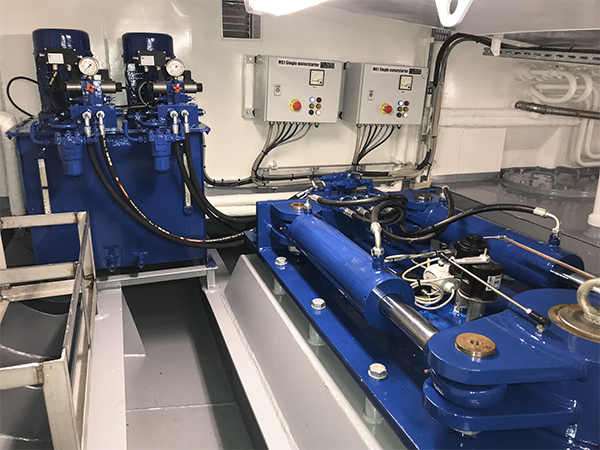
AS SCAN steering gear mounted onboard the Swedish newbuilding GG 500 - Vingaskär
How does a rotary vane steering gear work?
The rotary vane system operates by applying pressure to compartments created between a stator fixed to the ship's frame and a rotor connected to the rudder stock. The rotor has two or three vanes, and an equal number are present on the stator to establish the compartments. When steering force is needed, pressure is increased in the relevant compartments. The pressure acts against the fixed vanes and propels the rotor (and the rudder stock) in the desired direction.
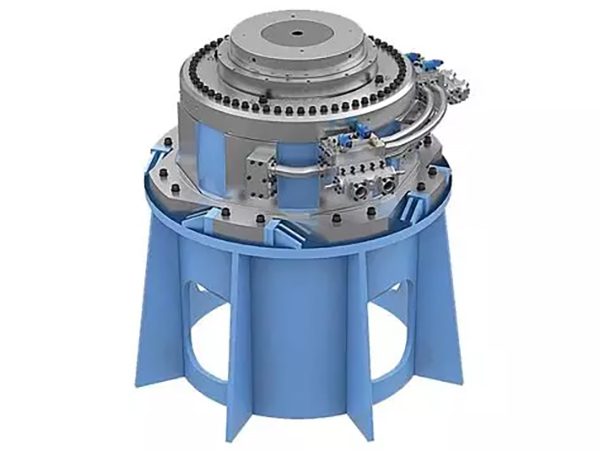
Rolls Royce rotary vane steering gear
To enhance available torque, the unit's diameter is increased, although it is generally smaller than a comparable ram-type setup. Hydraulic pressures are also decreased since the working area is larger than the combined total of rams in a ram-type gear. An additional benefit is the range of rudder movement is provided up to 65° depending on the maker type. In contrast, ram-operated gears have limited rudder movement due to cylinder stroke and slider mechanism restrictions. A potential drawback of the rotary vane system is that if an internal fault occurs, complete steering loss can happen and specialized repair becomes necessary. For larger vessels with ram-type gears, four single-acting cylinders ensure that steering isn't completely disabled if one ram fails. Moreover, working components are easily accessible for repairs, and if a spare is available, replacing rams can be relatively straightforward.
Key Components of RAM Type Steering Gear
The primary components of a RAM type steering gear include:
Steering Control System:
This is essentially the command center. It's where the helmsman controls the direction of the ship. Inputs made here are sent to the other components to execute the desired maneuvers.
Motor Starter:
This component is responsible for initiating the motor that drives the pump unit. It regulates the electrical supply to the motor, ensuring that it starts and operates efficiently.
Hydraulic Power Unit (HPU):
This is the heart of the hydraulic system that powers the steering mechanism. It generates the necessary hydraulic pressure to actuate the steering gear, and usually includes a pump, accumulator, and reservoir.
RAM Steering Gear:
This is the mechanism that physically turns the rudder based on commands from the control panel. It transforms hydraulic pressure from the pump unit into mechanical force.
Rudder:
A flat piece, usually made of steel, located at the stern. It's pivotal in steering the ship as it deflects water flow, causing the vessel to turn.
This illustration provides an insight in the intricate components that ensure smooth and precise navigation of marine vessels. From the wheelhouse with control panel to the steering gear room with steering gear. Each part plays a crucial role in maneuvering the ship safely.
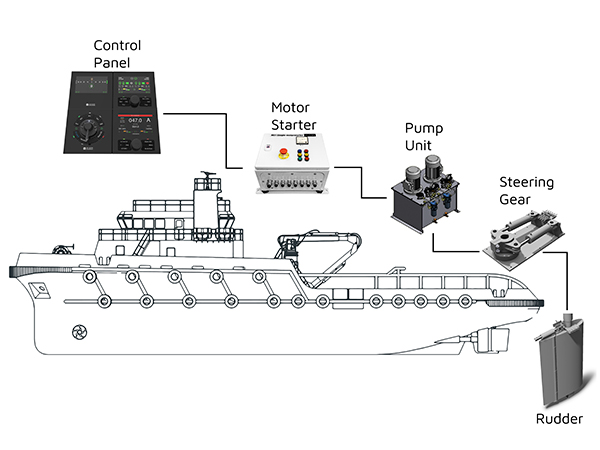
Overview of the main components in a AS SCAN steering system
Other system components
- Rotary Valve: This component controls the flow of hydraulic fluid in response to the movement of the steering wheel or autopilot system.
- Relief Valves: They protect the hydraulic system from excessive pressure buildup by allowing excess fluid to escape when needed.
- Rudder Stock: A vertical rod connected to the rudder that transmits rotational motion from the ram assembly to steer the vessel.
- Tiller Arm: This connects the hydraulic ram to the rudder stock and multiplies the force generated by the ram.
- Non-return Valves: These valves prevent backflow of hydraulic fluid, ensuring that any leakage does not compromise the operation of the steering gear system.
Key Components of Rotary Vane Type Steering Gear
The components comprising a rotary vane steering gear typically consist of:
Steering Control Panel:
This is the central hub from which the direction of the ship is managed. The helmsman inputs commands here which are then relayed to the other components to enact the desired movements.
Motor Starter:
This vital component initiates the operation of the motor that sets the pump unit in motion. It manages the electrical power to the motor, ensuring a smooth start and efficient continued operation.
Pump Unit:
This is the core of the hydraulic system that powers the steering mechanism. It produces the requisite hydraulic pressure to activate the steering gear.
Rotary Vane Steering Gear:
The rotary vane is the heart of the steering gear system. It is a flat, rectangular plate or a curved surface attached to the rotor. As the rotor rotates, the vane moves within a circular chamber, dividing it into separate compartments. This movement creates pressure on the hydraulic fluid, enabling it to transfer torque to the steering system.
Rudder:
A rudder is typically flat and made of steel, it is mounted at the stern (rear) of the ship. The rudder's primary function is to control the vessel's steering and direction. It accomplishes this by deflecting water flow when turned. The resulting force, applied at the ship's stern, causes the vessel to change direction.
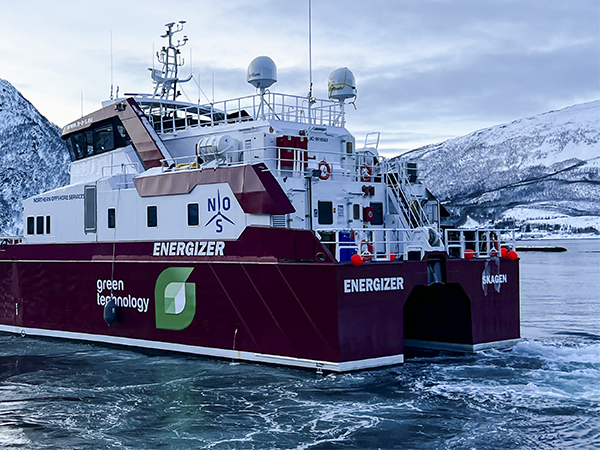
Norwegian catamaran using steering gear and rudder to maneuvering
Other system components:
- Rotor: The rotor is the central component that holds the rotary vane in place and is responsible for rotating it within the chamber. It connects to the hydraulic pump and helps in transmitting hydraulic power from the pump to the steering mechanism.
- Circular Chamber/Housing: The circular chamber, also known as housing, encloses all moving parts of the steering gear system, such as the rotor, vane, and bearings. It provides a sealed environment to retain hydraulic fluid with smooth walls for minimal friction during operation.
- Bearings: Bearings are crucial components in any rotary system, as they facilitate smooth rotation between moving parts while reducing friction and wear over time. In a rotary vane type steering gear system, bearings provide support for both axial and radial loads within the housing.
- Control Valves: Control valves regulate fluid flow through the system based on input from sensors that detect wheel position or driver inputs such as turning force at steering wheel. They open or close as needed to manipulate hydraulic flow rates and consequently control vehicle direction.
- Actuators/Steering Cylinder: These components convert hydraulic power generated by the pumps and transmitted via control valves into mechanical motion.
Advantages of RAM Type Steering Gear
The RAM type steering gear is a popular choice for marine applications, offering several advantages over other steering mechanisms. Some of its key benefits include:
- High efficiency and precision: RAM type steering gears are known for their efficiency and precise steering capabilities. This is mainly because they provide a linear, direct force to the rudder stock, ensuring optimal control over the vessel’s movement.
- Low maintenance: Due to their simple and robust design, RAM type steering gears require less maintenance compared to more complex systems. This results in reduced operational costs as well as minimal downtime for repairs or upkeep.
- Durability and reliability: The compact and sturdy design of RAM type steering gear units ensures durability and long-lasting performance under demanding marine conditions. High-quality materials, such as marine-grade steel, further add to their longevity and dependability.
- Wide range of applications: RAM type steering gears can be installed on various types of vessels, including small craft, fishing boats, tugs, offshore supply vessels, and more. Moreover, they are available in different sizes and configurations to accommodate various requirements.
- Ease of installation: The straightforward design of RAM type steering gears makes them relatively easy to install. This contributes to reduced installation costs and enables shipyards to complete construction projects more efficiently.
- Energy saving: As RAM type steering gears generate minimal resistance during operation, they consume less power compared to some other systems. This results in reduced fuel consumption and lower overall operating costs for the vessel
Advantages of rotary vane type Steering Gear
The rotary vane type steering gear offers several advantages over other types of steering systems. Some of these benefits include:
- Compact Design: Rotary vane steering gears have a smaller footprint compared to other steering systems, making them ideal for space-constrained applications.
- High Efficiency: The rotary vane design allows for a smooth and continuous flow of hydraulic fluid, resulting in higher efficiency and faster response times when maneuvering the vessel.
- Precise control: The precise control offered by rotary vane steering gears allows for superior maneuverability, even in challenging conditions.
- Noise reduction: The continuous and smooth fluid flow within the system leads to lower noise levels, creating a quieter working environment for operators and crew members.
- Versatility: Rotary vane steering gears can be used in various vessel types and sizes, but mainly ranging from medium size boats to larger commercial ships.
Watch this video to learn how ship steering gears works.
Non follow up (NFU) and follow up (FU) steering
A ship has two main steering methods: follow up and non follow up. These steering levers are vital when maneuvering larger boats, where manually turning a steering wheel just isn't quick enough. For instance, on some boats, it takes 10 turns turns to go from hard over to hard over, and it's not something one can perform single-handedly. Here's how they work and how you can use them.
Non follow up
NFU Steering control is the cost-effective and safest means of steering control, but not very comfortable. The rudder moves as long as the NFU-Tiller is operated and stops, when the tiller is released or the rudder limits are reached. A non follow up (NFU) lever consists of three separate control positions. When centered, there is no rudder movement, maintaining its current position. Moving the lever to the right causes the rudder to shift right. As long as the lever remains to the right (it is spring-loaded and will return to center if released), the rudder continues its rightward motion until reaching its limit.
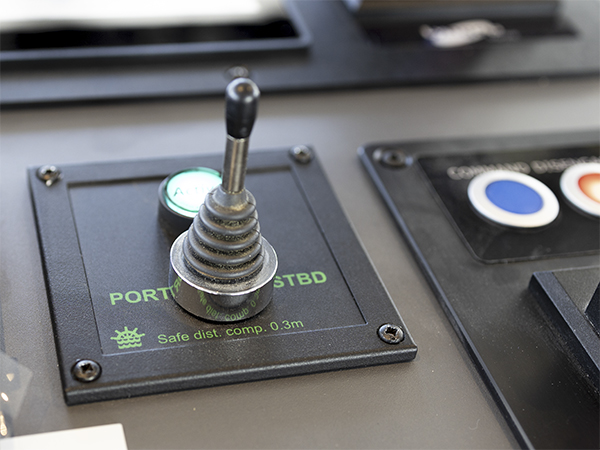
Non follow up lever mounted onboard the Norwegian vessel »Skulebas«
Moving the lever to the left initiates leftward rudder movement. Consequently, with an NFU control, you command rudder motion rather than a specific position, as in a follow up (FU) control. This lever could be referred to as a dodge lever.
Follow up (manual & autopilot)
FU steering is comfortable and user-friendly but also more expensive than a non follow up. A Follow up (FU) lever is quite simple to understand. FU steering is a control of the rudder angle and is essentially a FU handwheel utilized for positioning the rudder. The rudder follows the preset angle (rudder command) of the FU handwheel and stops when this is reached. Center the lever and the rudder centers. Turn it to 15 degrees port, and the rudder shifts to 15 degrees port as well.

AS SCAN steering lever on which the user can choose whether it should function as follow up or non follow up
Rotary vane vs RAM type Steering Gear - which one should I choose?
When choosing between a rotary vane and RAM type steering gear for your vessel, there are several factors to consider. Here, we'll discuss the main differences, advantages, and drawbacks of each system to help you make a more informed decision.
- Application: The primary consideration should be the specific application for which the steering gear will be used. Rotary Vane Steering Gears are more suitable for larger vessels, while RAM type is popular amongst small and medium-sized ships.
- Performance and Efficiency: Rotary vane steering gears are known for their high efficiency as they transmit power directly to the rudder with minimal energy loss. They deliver smooth performance and require less power compared to RAM type steering gears. On the other hand, RAM type Steering Gears are known for their robustness, with the ability to handle higher loads and extreme environmental conditions.
- Space Requirements: Rotary vane steering gear systems have compact designs compared to their RAM type counterparts, which can be advantageous in installations with restrictive space. RAM type steering gears tend to be larger in size due to the arrangement of the hydraulic cylinder and piston.
- Maintenance and Reliability: RAM type systems offer greater reliability due to fewer moving parts, resulting in reduced wear and tear and lower maintenance requirements. Rotary vane steering gears often require more frequent maintenance due a more advanced system.
- Rotary vane steering gear systems tend to be relatively more expensive upfront and i more expensive to install. Conversely, RAM type systems are generally less expensive and easy to install.
In conclusion, it's essential to carefully evaluate your vessel's requirements before choosing between a rotary vane or RAM type steering gear system. Factors such as performance, efficiency, space requirements, maintenance, cost, and application all play a crucial role. By considering these factors and consulting with experts such as AS SCAN engineers, you'll be better equipped to select the ideal steering gear system for your vessel.

